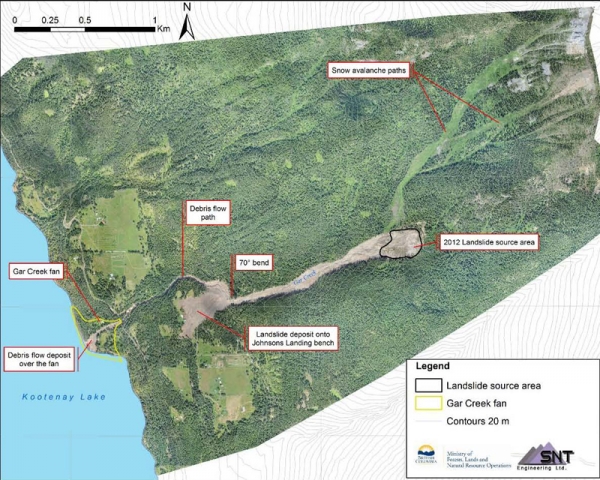More bad news for Johnsons Landing residents
By Suzy Hamilton, The Nelson Daily
Johnsons Landing residents who lost their homes last summer in a massive slide received another crushing blow Wednesday at a private meeting with Emergency Management BC.
Province officials told five of the affected landowners it will not buy their land and return it to the Crown, according to Johnsons Landing resident Harvey Armstrong.
Armstrong lost his home and pottery studio in the slide that took four lives on July 12, 2012. He said returning the land to the Crown was the only way to ensure it will not be occupied.
“This is a double whammy for me. I still have to pay taxes on the land and I am liable if anyone is on my land if another slide comes down,” he said.
A second slide is very likely, said an extensive geotechnical report prepared for the Regional District of Central Kootenay.
Sixty-year-old Valentine Webber and his daughters, 22-year-old Diana and 17-year-old Rachel, died when at least three homes were engulfed as the massive slide tore through the tiny hamlet on at approximately 10 a.m.
The massive mudslide also claimed a fourth victim, 64-year-old German national Petra Frehse.
Mountains of log-studded debris remain piled as much as 10 metres deep around the shattered homes.
The report, released Thursday by the Regional District of Central Kootenay, said that the probability is high that a second slide, some three times the size of the first one, could come down the same path as the first one.
“This land is going to be a hazard forever,” said Armstrong. “The whole thing sucks.”
The study was commissioned by the RDCK to determine the likelihood of further landslide activity and to determine the hazard to residents both over the short term (summer and winter of 2012) and the long term.
The 112-page report examined the hazards, risks, and contributing factors to the slide.
Approximately 320,000 m3 of soil and rock traveled at speeds of up to 150 km/h down the Gar Creek Channel.
Much of the landslide debris flowed out of the channel and onto the Johnsons Landing bench, destroying four homes and causing the loss of four lives, the report said.
Three sections of public road were taken out. Only one section has been repaired, said Armstrong, because of the high hazard of repairing the other two sections.
The community water system was also destroyed. The report concluded that record June rainfall and late snow melt triggered the slide.
Furthermore, a slide of this magnitude has not occurred in the last 12,000 years.
“There is potential for future landslides in the Gar Creek drainage,” the report said.
“The likelihood of a landslide and debris flow that is contained within the Gar Creek channel flowing over the Gar Creek fan and into Kootenay Lake is estimated at 1:10 per year.
“The results of the landslide assessment and risk analyses indicate that some residents, users of the Argenta-Johnsons Landing and Houston Roads users of the Community Hall and users of the beach area are exposed to continued landslide and debris flow hazards.”
The report made eight recommendations, including “restricting further land/house developments in the areas identified as having a moderate, high or very high hazard unless subsequent geotechnical investigations are conducted.
” It also recommended that public awareness “be increased to be able to report signs of unusual creek activity and slope instability.”
The report, however, did not recommend that the province gain control of the land to prevent further development.
“We were told by Doug Nicol, one of the authors of the report, that they couldn’t make that recommendation because it was political,” said Armstrong.
A meeting to discuss the report with Johnsons Landing residents was held Thursday night after press time in Argenta.
Armstrong was miffed that the meeting had “morphed into a media show,” but said he was making the drive to Argenta to attend the meeting.
“I’m going to pursue this as well as I can. It’s too unfair.”


























Comments